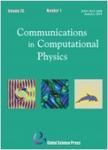A Weak Galerkin Mixed Finite Element Method for Second Order Elliptic Equations on 2D Curved Domains
作者机构:School of Mathematical SciencesNanjing Normal UniversityNanjing 210023China School of Mathematical SciencesFudan UniversityShanghai 200433China Shanghai Key Laboratory for Contemporary Applied MathematicsFudan UniversityShanghai 200433China Jiangsu Key Laboratory for NSLSCSNanjing Normal UniversityNanjing 210023China
出 版 物:《Communications in Computational Physics》 (计算物理通讯(英文))
年 卷 期:2022年第32卷第9期
页 面:1094-1128页
核心收录:
学科分类:07[理学] 0701[理学-数学] 070101[理学-基础数学]
基 金:supported by Postgraduate Research&Practice Innovation Program of Jiangsu Province 1812000024768 supported by the NSFC grant 12171244.Chen is supported by NSFC grant 12071090
主 题:Weak Galerkin method polygonal mesh curved domain mixed formulation
摘 要:This article concerns the weak Galerkin mixed finite element method(WGMFEM)for second order elliptic equations on 2D domains with curved *** Neumann boundary condition is considered since it becomes the essential boundary condition in this *** is well-known that the discrepancy between the curved physical domain and the polygonal approximation domain leads to a loss of accuracy for discretizationwith polynomial order a*** purpose of this paper is ***,we present a detailed error analysis of the original WG-MFEM for solving problems on curved domains,which exhibits an O(h^(1/2))convergence for all a≥*** is a little surprising to see that even the lowest-order WG-MFEM(a=1)experiences a loss of *** is different from known results for the finite element method(FEM)or the mixed FEM,and appears to be a combined effect of the WG-MFEM design and the fact that the outward normal vector on the polygonal approximation domain is different from the one on the curved ***,we propose a remedy to bring the approximation rate back to optimal by employing two *** is a specially designed boundary correction *** other is to take full advantage of the nice feature that weak Galerkin discretization can be defined on polygonal meshes,which allows the curved boundary to be better approximated by multiple short edges without increasing the total number of mesh *** analysis shows that a combination of the above two techniques renders optimal convergence for all *** results further confirm this conclusion.



